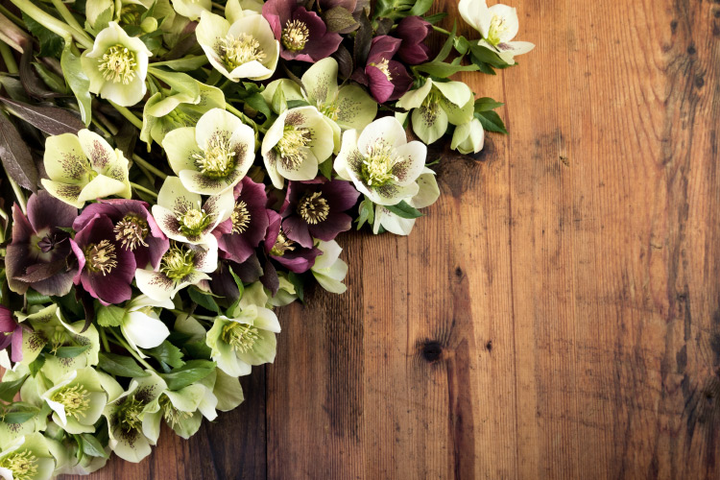
Christmas rose, also known as ‘Bear’s Foot’, comes from the Ranunculaceae family and is a Helleborus genus.
It boasts dark, green leathery foliage and large, bowl-shaped flowers in shades of white and pink-tinged white.
These blooms, unlike others, come to life in late winter. This particular species of plant can be found in Europe and South East Asia.
Christmas Rose ‐ Hellebore
Growing conditions
This winter-blooming evergreen is extremely easy to grow, when placed in the correct environment.
For best results, plant the Christmas rose in partial to full shade in a sheltered, north, east or west-facing location away from strong, cold winds. It’s able to flourish in a variety of alkaline and neutral soils including loam, clay and chalk. Regardless of which soil you choose, it’s important to keep it moist but well drained.
This species tends to grow in an upright; bushy clump and can reach a height of 8-12 inches, while measuring 12-18 inches wide.

How to grow the Christmas Rose
Propagate by seed in pots kept undercover in a cold frame, or alternatively, by division after flowering in early spring or late summer. Christmas rose is traditionally used to decorate flowerbeds, shady borders and containers. It’s also the perfect plant to use as groundcover, especially when grown in abundance.
When growing these plants from seed, it’s important to know that they can take between three and four years to reach full size.
When planting from seeds, it’s imperative you ensure the seeds are fresh, as germination is much slower when using dry seeds. Since the seed requires a cold treatment to sprout, it’s wise to keep the Christmas rose outdoors up until Christmas. For best results, plant directly in the ground rather than in a container.
If growing in a container, transplant them when they reach two inches in height. Although these species can take a little while to become established, once in place, they shouldn’t be moved.
Growing Christmas roses for the first time
If it is your first time growing Christmas roses, it is best to opt for less expensive variants, such as Helleborus niger. These are great tester plants and can be grown in smaller pots. If buying Christmas roses in flower, choose plants with rounded blooms and an abundance of healthy foliage. When established, water once a week to encourage new growth and deadhead on a regular basis. For longer lasting blooms, you should move your hellebores to slightly larger black plastic pots during the second half of summer every year. When doing so, add some slow-release fertiliser – hellebores are renowned for being extremely hungry plants. Once established, move them back to a warm, shaded area in late autumn.
If you find your Christmas roses are taking over after a few years, simply split them into two or three large pieces. This should only be done if completely necessary, as once in place, this perennial prefers to be left undisturbed.

Varieties of Christmas rose – Hellebore
All Christmas rose species are hardy garden plants that bloom both indoors and outside. Their large, white flowers tend to open within three to four weeks of arrival and can last up to two weeks if cared for correctly. Once you’ve tried your hand at growing the most common Christmas rose plants, you may wish to introduce other variants to your garden.
Walberton’s Rosemary: This particular variant of Christmas rose – Hellebore boasts beautiful pink flowers, which will add instant colour to an otherwise neutral garden.
Harvington Double White: This specie offers double blooms in a very pure white hue.
Potters Wheel: Again, this variant boasts pure white flowers, which are extremely round in shape and very floriferous.
Ashwood Strain: This type of Christmas rose comes in the purest white hue, with flowers in the shape of cups, which sit on strong stems.
Caring for Christmas rose
In order to ensure your Christmas rose flourishes to its best potential, it’s important to prune them regularly, by removing damaged foliage and faded leaves. This specie of plant is prone to certain pests, including hellebore snails and aphids, and is sometimes affected by hellebore leaf spot.
When plants are in active growth, during the months of April to September, it’s a good idea to use a balanced (20-20-20) houseplant fertiliser. This should be diluted to 1/4-strength and applied on a monthly basis. If you choose to transplant a Christmas rose that has been housed indoors, you will need to fertilise it once a year in the spring, using a balanced (10-10-10) granular fertiliser.
Continuing Care
Christmas roses can be planted outside in the majority of locations, but it’s important to pick a shady location with well-drained, humus-rich soil and plant in the month of spring. Try to avoid planting when there is frost outside.

Origins of the Christmas rose
Hellebores are predominantly European natives, and can be found in open meadows in Croatia, Bosnia, Slovenia, Greece, Turkey and Italy. Some variants, including the deciduous species Helleborus thibetanus, are even found in China. While originally a full sun plant, Hellebores are the ideal option for light woodland gardens.